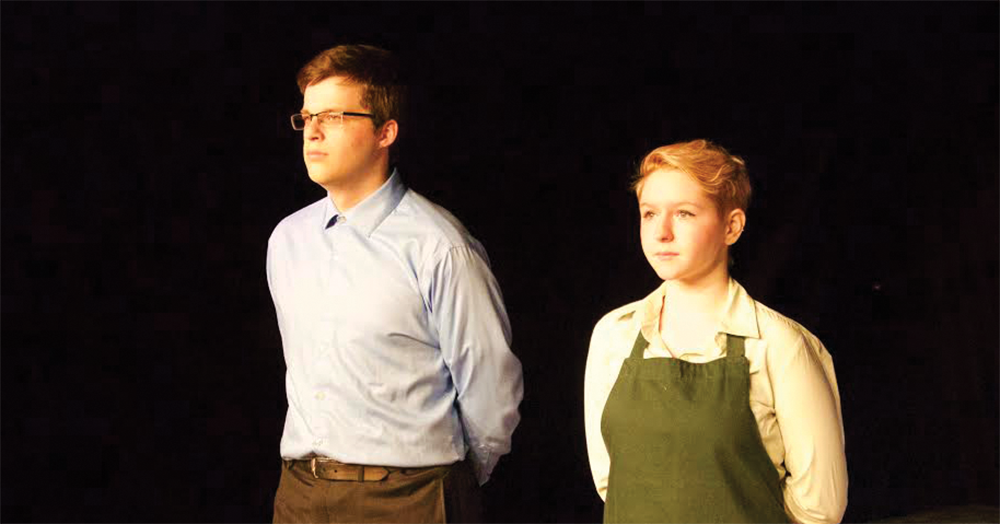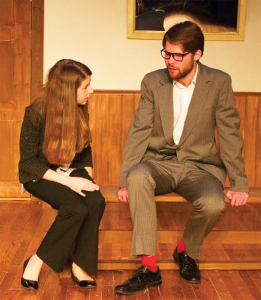
In collaboration with Georgetown’s Department of Performing Arts, the Mask and Bauble Dramatic Society presents the Donn B. Murphy One Acts Festival. Celebrating its 31st edition, the festival took place Feb. 16 to 18 and Feb. 23 to 25 at 8 p.m. at Poulton Hall Stage III.
Featuring two plays for the first time in 31 years, DBMOAF introduced “The Gun” by Grayson Ullman (COL ’16) and “Victimology” by Rachel Linton (SFS ’19). This year, Mask and Bauble’s Board 165, along with the department of performing arts, provided the festival with additional support to expand its repertoire.
“This year we were so lucky to have some great support from the Mask and Bauble Board 165, the department and all of the wonderful professionals there to expand this festival from what it has been in the past,” Student Director Makayla Kessel (SFS ’18) said. “Typically, we’ve only been able to produce a single one-act play, and this year we got to focus on two. This board has really committed to giving student-written works a greater place in this season, and I believe this support is going to continue to grow.”
An increasing appreciation of student talent — not just in acting, but in writing — has encouraged DBMOAF to expand its search of student-written plays from across the Georgetown community.
“This festival is the primary platform to showcase students’ plays. And, essentially, it is the primary platform not only for Mask and Bauble but across the theater community,” Student Producer Liliana Seabol (COL ’17) said. “Plenty of people apply and send in their plays, not just theater writers, but it includes people that you might even be surprised wrote a show. Whoever wants to submit something can.”
Mask and Bauble’s standing tradition of student involvement allowed for it to explore freely and develop the festival’s creative vision, guided and nurtured by professionals in the department of performing arts.
“I think a lot of times it’s great to do well-known shows, but I think it’s also important to highlight the fact that we have talented writers who are capable of creating really fantastic material and can generate truly enriching experiences if they’re just given the chance,” Seabol said.
The first play, “The Gun,” introduces a lifeless universe where Fred, who is a writer, and Tom, a clerk, encounter “the assignment,” which involves a handgun and vague instructions to get to the “real paradise,” where “there are fountains and color.” There is only one problem: They must decide which one of them gets there.
Reminiscent of Samuel Beckett’s tragicomic “Waiting for Godot” and Eugène Ionesco’s absurdist dramas, “The Gun” opens with dense dialogue sequences between Tom and Fred, who wonder about life’s eternal, accidental and unnerving character.
“We read Grayson’s paradise as a purgatory, and we emphasized the concept of a purgatory in the mind,” Kessel said. “You hear those bodily sounds: the heartbeat, the blood rush. They emphasize this idea of being stuck in the body but also outside of the body.”
“Victimology,” the second play, explores the story of siblings Aidan and Dani, who suffered from abuse by their alcoholic father after their mother’s death. Their conversation slowly reveals the extent of their injuries, both physical and mental. The siblings unexpectedly meet outside the courtroom where their father is facing trial after having spent the last 10 years in prison.
“The challenge of the play is to have the characters only say what is pressured out of them in a situation. They have waited 10 years to have this conversation. I think the setting, the fact that they are here and don’t expect each other to be here and have these conflicting purposes for being here, enriches their exchanges,” Linton said. “If characters have uneven knowledge, they can inform each other, and the audience gets to find out along with them. Part of the play is about uneven knowledge, but mainly it is about the discordance of memory between people who went through a trauma together.”

The most innovative element of the festival lies in its mime sequences, workshopped by the cast as a complementary dynamic to the heavy dialogue scenes of both plays. The mimes, dressed in black and completely silent, are accompanied by an exquisite soundtrack that captures the subtleties of memory and abstract streams of consciousness. The mimes’ depictions of Dani’s and Aidan’s memories provide an opportunity to uncover the nuances behind each narrative.
“It’s very interesting to tell a story where, as the audience, you’ve seen what happens at the end and then the mime sequences put the pieces together,” Kessel said. “The mimes serve to provide a backstory. The mimes give you more information as an audience member, and the play’s pieces begin to fall into place. Both ‘The Gun’ and ‘Victimology’ tell the stories of what has happened to the characters that are initially presented.”
Besides an enriched narrative, the contrast between the mimes and traditional dialogue scenes allows audiences to experience both the formal aspects of trauma, as well as the cognitive processes associated with memory and abstract thought.
“The mime sequences along the opening acts mirror reality in a way that is very interesting, because you think about situations where there is a haze and a series of vague concepts in your head about what happened and how it happened,” Seabol said. “I think the mimes give the audience an idea of the way memory works and how things happen in our minds whenever we recollect these moments.”
Ultimately, DBMOAF parallels the themes of anxiety and survival present in both plays with the very essence of theater through creative repetition, emphasis and form.
“Anxiety gets stuck on something and loops and keeps coming back. So much in theater is about looping back, so this anxiety is particularly interesting to explore within the structure of a play.”
DBMOAF offered an evening of reflection on difficult subjects, providing complex, thought-provoking material that is bound to spur both deep emotion and illuminating thought.



















